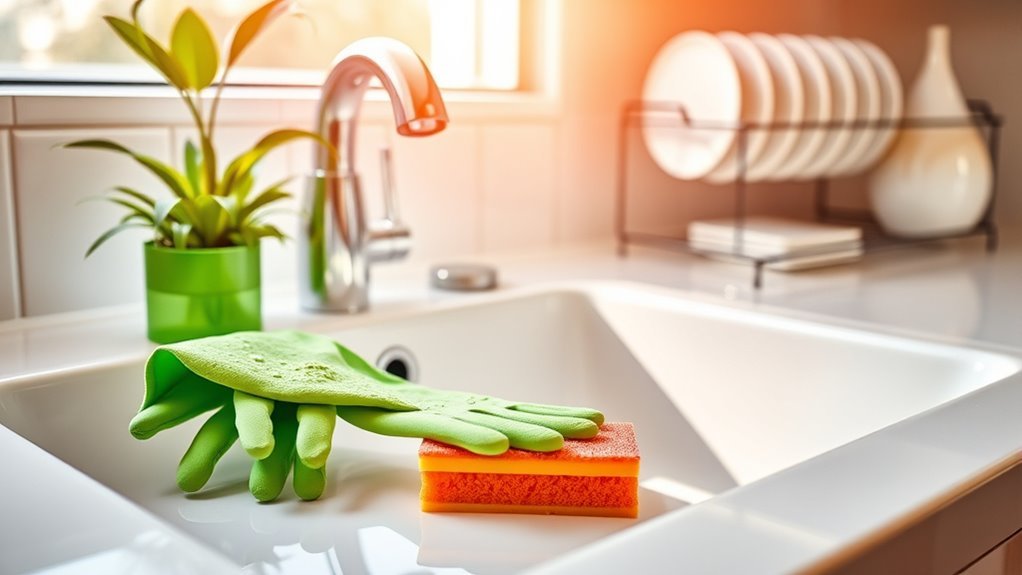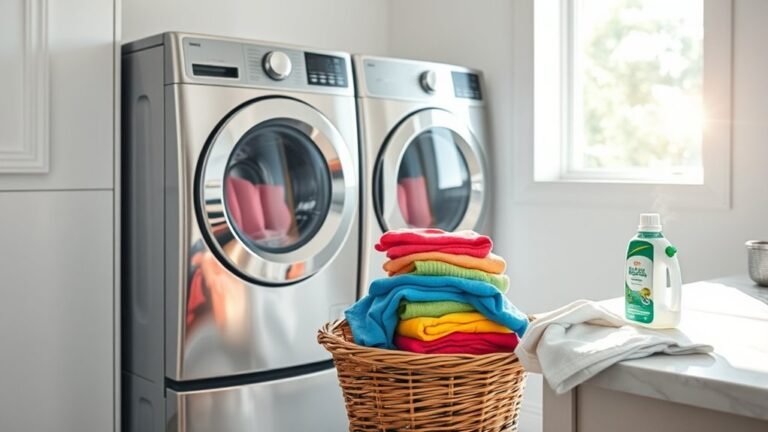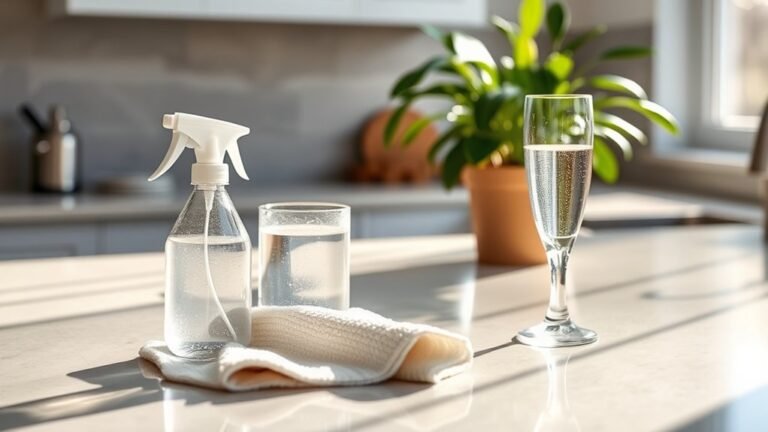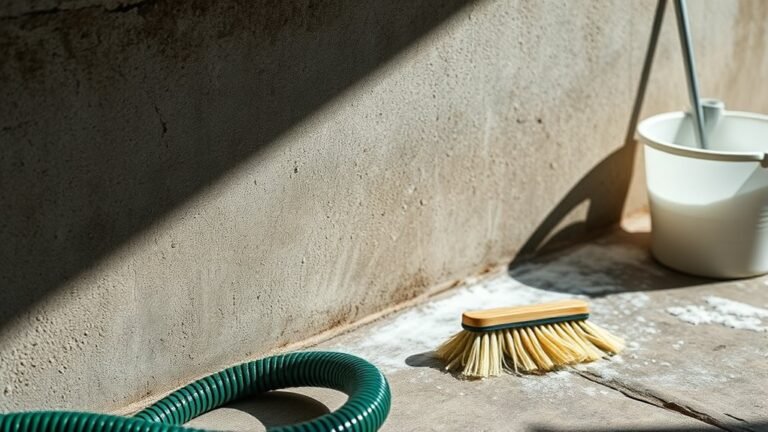How to Clean Your Home After Sink
After your sink overflows, you’ll want to quickly turn off the water and electricity to prevent damage and hazards. Remove standing water using a wet vacuum or mop, then thoroughly dry all surfaces with towels and fans. Clean and disinfect every spot the water touched to stop mold growth. Keep an eye out for leaks or damage to fix early. If you follow these steps, you’ll protect your home and can explore further tips to restore everything safely and fully.
Assessing the Damage and Safety Precautions

Before you begin cleaning up after a sink overflow, it’s important to assess the extent of the damage and take necessary safety precautions. Start by conducting a thorough damage assessment—check for water pooling, soaked flooring, and any affected belongings. This step helps you plan your cleanup effectively and prevents surprises later. Don’t rush in without the right safety gear; grab gloves, waterproof boots, and a mask to protect yourself from contaminants and mold. Wearing safety gear isn’t just about following rules—it’s about preserving your freedom to stay healthy and in control. Taking these initial precautions means you’re setting yourself up for a smoother, safer recovery, letting you reclaim your space without unnecessary risk or stress.
Turning Off Water Supply and Power Sources
Once you’ve assessed the damage, you’ll need to turn off the water supply to stop any further flooding. Locate your main water valve—usually near the water meter or where the pipe enters your home—and shut it off. This simple step gives you control, preventing more water from invading your space. Next, focus on power sources. Water and electricity don’t mix, so switch off the electricity in the affected areas at your circuit breaker to avoid shocks or electrical fires. If you’re unsure which breakers to flip, it’s safer to turn off the main power. Taking these actions puts you in the driver’s seat, securing your home and your freedom to manage the cleanup without added risk or damage.
Removing Standing Water and Excess Moisture

Now that the water supply is off, you’ll want to focus on removing any standing water quickly to prevent damage. Using a wet/dry vacuum or mop can make this task easier and more effective. Then, take steps to reduce moisture by ventilating the area and using dehumidifiers if needed.
Effective Water Removal
Although it might seem overwhelming, quickly removing standing water and excess moisture is essential to prevent further damage and mold growth. You can start by using effective water extraction methods like wet/dry vacuums or mops to pull out as much water as possible. If the flooding is significant, consider sump pump usage to efficiently remove large volumes of water from your home. Acting fast gives you the freedom to control the situation before it worsens. Make sure to focus on all affected areas, including under cabinets and behind appliances. Remember, the sooner you extract the water, the less chance there is for structural damage or lingering dampness that could compromise your home’s comfort and safety.
Moisture Prevention Tips
After getting rid of standing water, the next step is to focus on preventing moisture from lingering in your home. Effective moisture control helps avoid mold growth and structural damage. You’ll want to encourage air circulation, use dehumidifiers, and fix leaks promptly to guarantee dampness reduction. Here’s a quick guide to keep your space dry and fresh:
| Task | Tool/Method | Benefit |
|---|---|---|
| Ventilate rooms | Open windows/fans | Air circulation |
| Use dehumidifier | Electric dehumidifier | Lower humidity levels |
| Repair leaks | Plumber/DIY fixes | Stop moisture entry |
| Remove wet materials | Dispose or dry items | Prevent mold development |
Stick to these tips, and your home will stay comfortably dry and damage-free.
Drying Affected Areas Thoroughly
After removing excess water, grab some absorbent towels to soak up any lingering moisture. Make sure to open windows or turn on fans to keep the air flowing and help everything dry faster. Thorough drying prevents mold and damage, so don’t rush this step.
Use Absorbent Towels
One of the most important steps in cleaning up after a sink overflow is to use absorbent towels to dry the affected areas thoroughly. You want to grab towel types that soak up water quickly and efficiently—think microfiber or cotton towels, both known for their superior absorbent materials. Avoid using thin or decorative towels that won’t hold much moisture; you need something that works hard so you don’t have to. Press the towel firmly onto wet spots and keep swapping out damp towels for dry ones to speed up the drying process. This approach helps prevent water damage and mold growth, giving you control over your space without unnecessary hassle. Choosing the right towels makes a big difference in regaining order and freedom in your home.
Ensure Proper Airflow
While absorbent towels remove much of the moisture, you’ll need to guarantee proper airflow to dry the area completely. Using effective air circulation methods and ventilation techniques helps prevent mold and lingering dampness. Open windows, turn on fans, or use a dehumidifier to speed up drying. Here’s a quick guide to optimize airflow freedom:
| Method | Purpose | Tip |
|---|---|---|
| Open Windows | Natural ventilation | Cross-ventilate rooms |
| Use Fans | Increase air movement | Position near wet spots |
| Dehumidifier | Reduce humidity | Run until area is dry |
| Air Conditioner | Cool and dry air | Use if available |
| Remove Obstacles | Unblock airflow paths | Move furniture away |
Keep these ventilation techniques in mind to dry your home efficiently and regain control over your space.
Cleaning and Disinfecting Surfaces

Cleaning and disinfecting surfaces is a crucial step to guarantee your home is safe and hygienic after a sink issue. You’ll want to focus on surface sanitizing techniques that remove bacteria and grime efficiently. Start by wiping down all affected areas with warm, soapy water to clear away debris. Then, apply effective disinfectant solutions recommended for household use—look for those with proven germ-killing power. Make certain to cover countertops, cabinet faces, faucets, and any other surfaces that got splashed or dampened. Let the disinfectant sit for the time specified on the label to maximize its impact. This method guarantees you’re not just cleaning but truly sanitizing your space, giving you the freedom to enjoy your home without worry.
Handling and Cleaning Carpets and Rugs
Since carpets and rugs can trap moisture and contaminants after a sink incident, you’ll need to address them promptly to prevent mold and odors. Start by blotting any wet areas with clean towels—avoid rubbing, which can push moisture deeper. For effective carpet cleaning, use a wet-dry vacuum or rent a carpet cleaner to extract water thoroughly. If you have rugs, take them outside to air dry in the sun, which also helps eliminate bacteria. Remember, regular rug maintenance involves shaking out debris and spot-cleaning stains quickly. After drying, apply a suitable carpet cleaner to sanitize and refresh fibers. Handling carpets and rugs with care guarantees your home stays fresh and safe, giving you the freedom to enjoy your space without lingering issues from water damage.
Inspecting for Mold and Mildew Growth
Three key signs can help you spot mold and mildew growth after a sink incident: musty odors, visible discoloration, and persistent dampness. Using simple mold identification techniques, you can quickly assess whether mold has begun to develop in hidden areas. Early detection lets you apply mildew prevention strategies before the problem worsens. Check corners, under sinks, and behind cabinets where moisture lingers unnoticed.
| Sign | What to Do |
|---|---|
| Musty Odors | Ventilate area, use dehumidifier |
| Visible Discoloration | Clean with mold remover solution |
| Persistent Dampness | Dry area thoroughly, fix leaks |
| Hidden Spots | Use flashlight, inspect closely |
Stay proactive—freedom from mold means a healthier, fresher home environment.
Repairing or Replacing Damaged Fixtures
After checking for mold and mildew, the next step is to address any damaged fixtures caused by the sink issue. Start with a thorough fixture assessment to identify leaks, cracks, or corrosion that could be compromising your space’s functionality. Once you know the extent of the damage, explore your repair options—sometimes a simple seal or tightening can restore your fixture, while other times replacement is the only way to regain freedom from ongoing problems. Don’t hesitate to swap out outdated or broken parts for newer, more reliable fixtures that fit your lifestyle. Taking control here means you’re not just fixing a problem; you’re reclaiming your home’s comfort and independence, ensuring your sink area works smoothly on your terms.
Preventing Future Sink Leaks and Overflows
To keep your sink from leaking or overflowing again, you’ll want to schedule regular plumbing inspections. Paying attention to what you put down the drain can also prevent clogs and damage. These simple habits can save you from costly repairs down the line.
Regular Plumbing Inspections
Although it might seem unnecessary, regular plumbing inspections are essential to prevent future sink leaks and overflows. By scheduling routine plumbing maintenance, you gain peace of mind knowing small issues won’t turn into major headaches. Inspections help catch problems early through effective leak detection, saving you from costly repairs and water damage. You don’t have to live with the uncertainty of hidden leaks or corroded pipes. Taking control with consistent check-ups lets you enjoy your home freely, without worrying about unexpected water disasters. So, don’t skip these inspections—they’re your best defense in maintaining a reliable sink and protecting your space. Staying proactive means you can relax knowing your plumbing’s in great shape, giving you the freedom to focus on what truly matters.
Proper Waste Disposal
Keeping up with plumbing inspections is a great step, but how you manage what goes down your sink plays a big role in preventing leaks and overflows. To keep your pipes clear and your home free from water damage, you need to be mindful about waste disposal. Follow these simple practices:
- Stick to local recycling guidelines to avoid flushing non-degradable items that clog drains.
- Use composting tips to divert food scraps away from the sink, reducing buildup and odors.
- Avoid pouring grease or oil down the drain since they solidify and cause blockages.
When to Call a Professional for Help
If you’re dealing with a severe clog or persistent leaks after a sink overflow, it’s best to call a professional for help. Knowing when to seek help is essential to prevent further damage and save yourself from unnecessary stress. If your DIY efforts don’t clear the blockage or you notice water pooling beneath cabinets, it’s time to contact professional plumbing services. They have the tools and expertise to handle complex issues efficiently, ensuring your home stays safe and dry. Don’t wait until the problem worsens; timely intervention keeps repairs manageable and protects your freedom to enjoy a clean, comfortable space. Remember, calling a professional isn’t a sign of failure—it’s smart decision-making that preserves your home’s integrity and your peace of mind.
Frequently Asked Questions
What Household Items Can I Use to Unclog My Sink Drain?
If your sink’s clogged, you can tackle it with simple household items. Try pouring a cup of baking soda down the drain, followed by a cup of vinegar solution; let it fizz for 15 minutes. Then, flush it with boiling water to clear the grime. For tougher clogs, mix salt with baking soda, pour it in, wait a bit, and rinse with boiling water. It’s a freeing, chemical-free way to fix your drain!
How Often Should I Inspect My Plumbing for Leaks?
You should inspect your plumbing for leaks at least twice a year to keep things running smoothly. Regular plumbing maintenance helps you catch issues early, so you’re not stuck with costly repairs or water damage. Make leak detection part of your routine, especially after extreme weather or if you notice higher water bills. Staying on top of this gives you the freedom to enjoy your home without unexpected plumbing hassles.
Can Certain Plants Help Absorb Excess Moisture Indoors?
Imagine a knight’s shield, protecting your castle from invading dampness—that’s what moisture absorbing plants do for your home. You can totally harness these natural warriors like peace lilies, Boston ferns, and spider plants to tackle indoor humidity reduction. They soak up excess moisture, giving you fresher air and a more comfortable living space. By welcoming these green allies, you’re embracing freedom from stuffy, clammy rooms—no heavy-duty gadgets needed.
What Are the Best Natural Cleaners for Kitchen Sinks?
When you want the best natural cleaners for kitchen sinks, you can’t go wrong with a vinegar solution and baking soda. You’ll love how vinegar cuts through grime and kills bacteria, while baking soda acts as a gentle abrasive to scrub away stains. Just sprinkle baking soda, spray vinegar solution, let it fizz, then rinse. It’s simple, effective, and keeps your kitchen fresh without harsh chemicals, giving you freedom from toxins.
How Do I Maintain a Garbage Disposal to Prevent Odors?
To keep your garbage disposal fresh, focus on regular garbage disposal maintenance. Run cold water while using it, and avoid grinding fibrous or starchy foods that cause clogs. For odor prevention tips, grind citrus peels or ice cubes with a bit of baking soda to clean and freshen the unit naturally. Doing this weekly gives you freedom from bad smells and keeps your kitchen smelling great without harsh chemicals.






